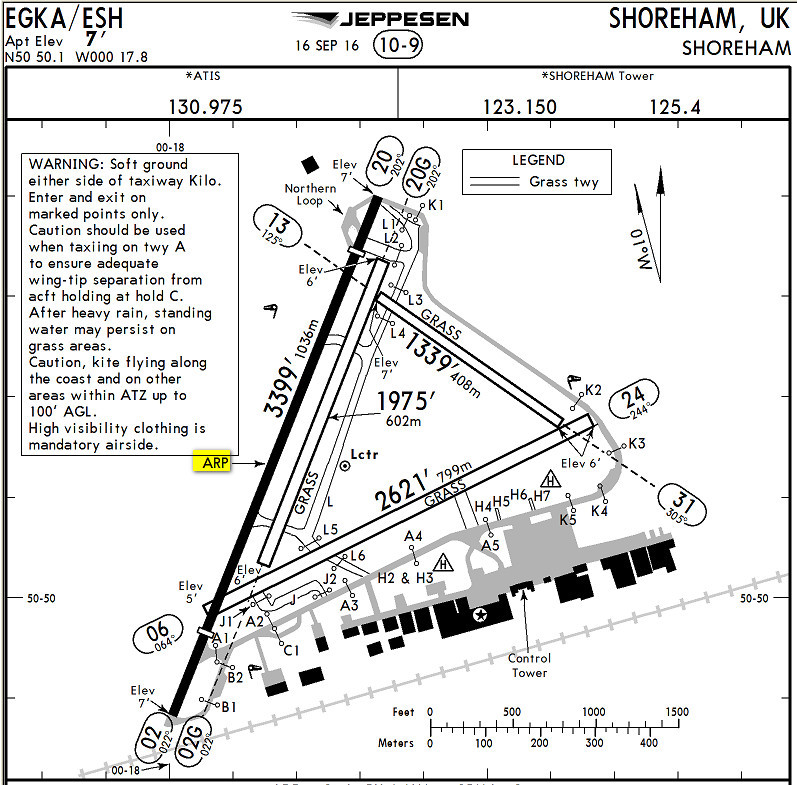Is the RWY waypoint in a GPS IAP not equivalent to DME=0?
Is the RWY waypoint in a GPS IAP not equivalent to DME=0?
The issue here is that you don’t have a GPS IAP to start with but are somehow using a GPS in place of a DME.
Normally, if you set e.g. EGKA as the waypoint, you get the ARP (aerodrome reference point) which defaults to the centre of the principal instrument runway

Whereas DME=0 would be the TDZ (touchdown zone)

There is simply nothing in the GPS database for EGKA corresponding to DME=0 (TDZ) or DME=1 (MAP).
This was done to death already. The answer is – maybe.
Rather than doing that again: When substituting GPS for a missing DME, more homework is required unless the DME is colocated with the NDB or VOR final approach aid. This increases potential for error. In many cases, this is trivial, and even if you get it wrong a bit, it won’t kill you (e.g., on an ILS, where the DME is really only a cross check). In some instances, it can be quite tricky (NDB/DME approach with non-collocated DME and no overlay in the database – have fun with that one).
Depending on how often you do that, how diligent you are, and other factors each pilot should be able to decide whether to take that risk, or not. The FAA has decided that it is up to the pilot/operator.
Personally, I would still buy or repair a DME, but I completely understand if others think that they don’t want to spend that much money for the rather remote risk of death.
Ultranomad wrote:
The main risk of using GPS for DME is not the difference between slanted and horizontal distance but rather measuring the GPS distance from the wrong point. Most GPS devices indicate only the distance to the next waypoint, while the DME may be up to 3-4 waypoints away, or not in the flight plan at all, or, worse yet, not even in the database.There was a CFIT accident in Scotland on a non-precision approach where the evidence strongly suggests that the crew was using GPS distance to the wrong waypoint in lieu of DME distance. The actual descent profile was exactly offset from the correct one by the distance between the DME station and a GPS waypoint. That accident has been discussed on EuroGA.
Yes – link posted above.
I will see if I can one day merge all the “GPS for DME” threads into one big one 
A search for
gps substitution
digs out several.
It’s a lot of work for me to merge threads though, and they can’t be merged if they overlap in time because the result would be nonsense.
For me this is far more a human factors issue, those above have may have made the technical point very well an I accept that if things are correctly programmed GPS distance is satisfactory.
The problems start when the workload is high and there are multiple radio aids with the same ident, I will bet that not a week goes by without an airliner approaching Larnica from the north and cleared to the VOR ( on the field ) ends up heading for the NDB (about 4 miles west of the field ) when an over eager pilot accepts the first LCA presented to him in the FMC and the LNAV heads for the wrong place.
Errors like this are easy to make when the workload is high when there is no check on the aid being used, at least with a DME you have to tune the unit and listen to the ident leaving very little room for error.
To be able to afford to fly IFR in your own aircraft you must already be a high achiever and I think some of the "don’t need DME attitude " comes from being an above average achiever who thinks he can operate the GPS substituted for DME situation without error, add to this the abcence of the cross check that you would find on an airliner flight deck and eventually all the holes in the Swiss cheese will line up.
WoW !
How all those American pilots have avoided almost certain death over the last 18 years, is just mind boggling.
Michael.
That is precisely the attitude that ends in the side of a hill.
… and that is PRECISELY what is NOT happening where it is 100% legal and common practice to use a GPS for a DME fix, 18 years running.
Pushing this subject just a bit further:
What is the reliability of [ antiquated ] DME equipment ?
How many accidents have been a direct result of DME mal-function ?
How often are DME transmitter stations out -of-service ?
What is the reliability of GPS service VS DME stations ?
How about the precision of DME ? Compared to GPS or WAAS ?